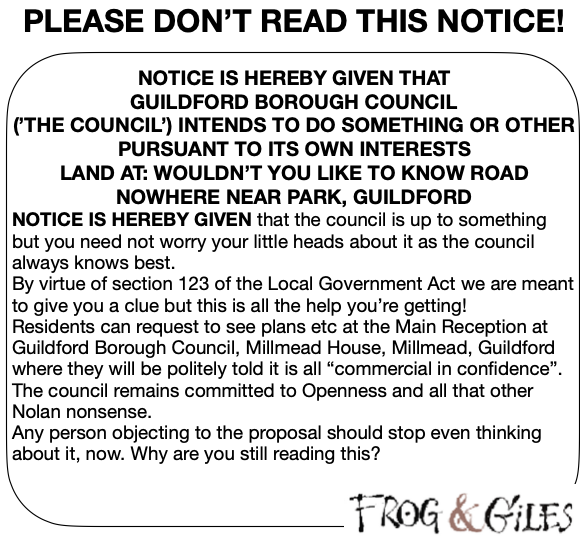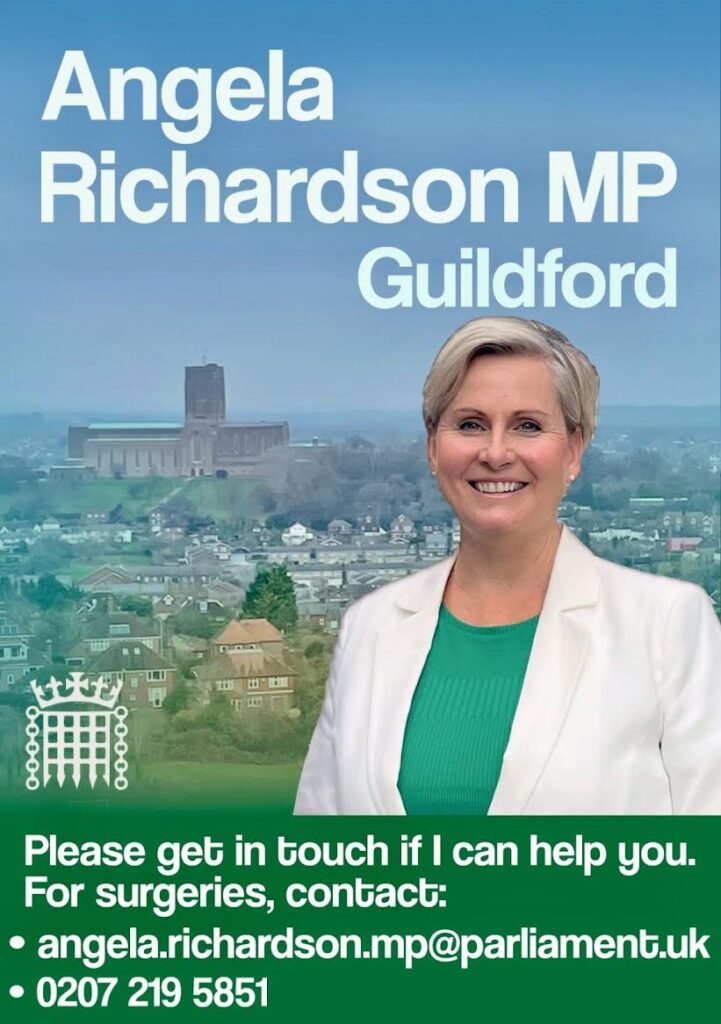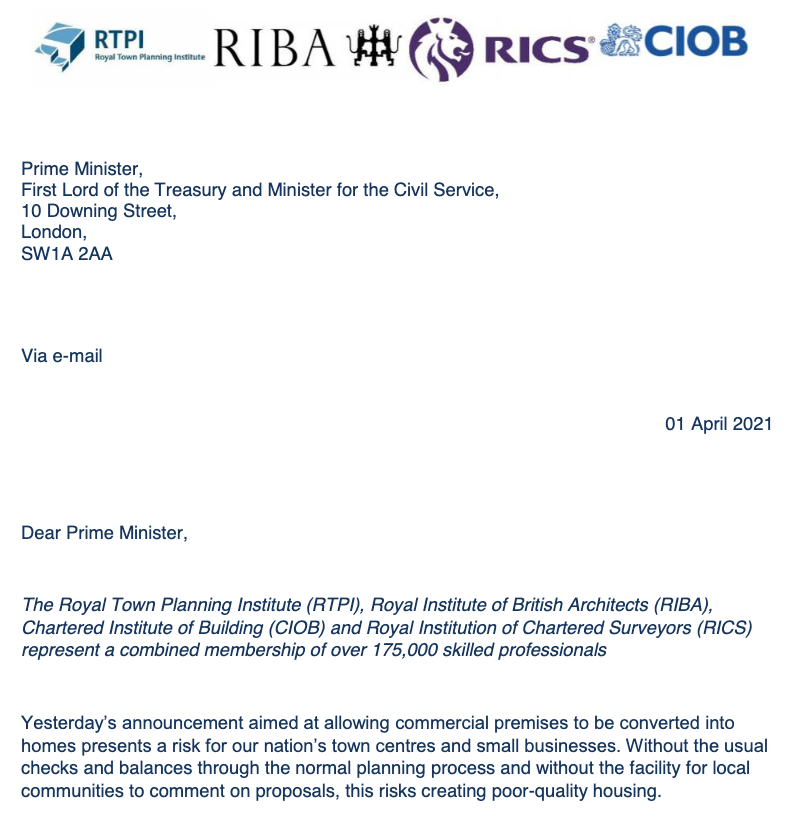 Abraham Lincoln
If given the truth, the people can be depended upon to meet any national crisis...
Abraham Lincoln
If given the truth, the people can be depended upon to meet any national crisis...
 Guildford news...
for Guildford people, brought to you by Guildford reporters - Guildford's own news service
Guildford news...
for Guildford people, brought to you by Guildford reporters - Guildford's own news service
Whitehall Planning Changes Unleash Developers, Society Warns Guildford
Published on: 2 May, 2021
Updated on: 2 May, 2021
Local authorities including Guildford, already suffering under controversial Local Plans, face losing even more control of planning from regulation changes government has been issuing quietly for a year.
These allow developers, among other new powers, to increase the height of a house or block by up to two storeys and change use of dwellings and shops up to 1,500sq/m in size (average Tesco Metro is 1,000sq m). The impact on Guildford town centre particularly could be considerable.
 The warning was sounded by Alistair Smith, chair of the Guildford Society, who said Secretary Robert Jenrick’s Ministry of Housing Communities and Local Government (MHCLG) has altered permitted development rights (PDRs) and changes to use.
The warning was sounded by Alistair Smith, chair of the Guildford Society, who said Secretary Robert Jenrick’s Ministry of Housing Communities and Local Government (MHCLG) has altered permitted development rights (PDRs) and changes to use.
PDRs were introduced to cover minor changes to properties, for example fences and minor extensions.
They involve little paperwork and oversight from the planning authority. MHCLG has dramatically loosened PDR and usage regulations to unleash developers. Local authorities will have little control.
Developers have to submit only minimal information from which to judge proposals. This information centres on matters within the council’s remit, including traffic, external appearance, flooding and access to natural light. High street diversity, design, outlook from windows, external amenity space cannot be considered.
Providing proper support for such unplanned PDR developments related to hard infrastructure (electric, water, waste) and social infrastructure (schools, medical etc) would depend on ad hoc efforts by the agencies concerned.
The changes are difficult to access and understand. More major ones are due in August. And they have prompted a letter to Prime Minister Boris Johnson expressing serious concerns from the Royal Town Planning Institute (RTPI), the Royal Institute of British Architects (Riba), the Chartered Institute of Building (CIOB) and the Royal Institution of Chartered Surveyors (Rics), representing 175,000 professionals in planning, design and development.
The institutes highlight the importance of delivering good quality, well-placed and sustainable homes.
The RTPI wrote: “Planning regulations that will enable unused commercial buildings to be changed into homes risk tearing at the fabric of local communities and jeopardising the vibrancy of high streets.”
The Guildford Society has many fears of the new developer freedoms, Mr Smith said. Among them:
- Unconstrained conversion of retail to dwellings. The town’s retail landscape is likely to change but this should be managed to consolidate retail areas and complement them with other services and amenities;
- Ill-advised conversion of office space to dwellings. There are already two proposals for office conversions totalling 100-plus units applied for via “prior notification” as PDRs. The Society believes them badly designed;
- PDRs are unplanned and can be of a considerable size. Guildford’s infrastructure, ranging from GP provision to sewage capacity, is already creaking. The Local Plan has produced requirements for schools, medical facilities, power etc. PDRs have no infrastructure planned; and
- The PDR and usage policies have little integration to other planning policies and appear to undermine efforts to manage proper development for areas to have the correct mix of dwellings, commercial space, and amenities.
Mr Smith added: “Our impression is that MHCLG seems to be in chaos. The desire to build 300,000 dwellings per annum, respond to economic changes post-Covid, build better and build beautiful, and loosen PDR and use regulations appear to be several disjointed, badly integrated initiatives.
“In particular, the recent planning White Paper seems to be totally unrelated to the changes to PDRs. The Society believes PDRs should be a component of the White Paper.
“Most important of all, lessening the ability of local communities to manage planning is Whitehall ‘taking back control’ with a poor record of doing so.
“In the elections, we need councillors dedicated to standing up for local management of planning, to effectively manage the changes of tomorrow.”
The Guildford Society has written to the Parliamentary Select Committee examining PDRs. The Society attended a webinar held by Civic Voice, the national body for Civic Trusts, to discuss changes to PDRs and Use classification. Between 30 and 40 Civic Trusts were at the virtual meeting. All agreed the changes were dangerous and undermined the planning system.
For more information contact www.guildfordsociety.org.uk
Responses to Whitehall Planning Changes Unleash Developers, Society Warns Guildford
Leave a Comment Cancel replyPlease see our comments policy. All comments are moderated and may take time to appear.

See Dragon story: GBC’s Explanation of Major Land Sale Notice Error ‘Borders on Arrogant’ Says Councillor






Recent Articles
- Police and Crime Commissioner Candidate Interview – Paul Kennedy
- Staff Union Warns Surrey University of No Confidence Votes
- Invitation to Join Mass Bike Ride on Saturday, April 27
- Thames Water Clarify Compensation Payments
- Surrey Fire and Rescue Service Urges Us All To Be ‘Wildfire Aware’
- Police and Crime Commissioner Candidate Interview – Lisa Townsend
- Insights Part 3: The Council Should Not Be Marking Its Own Homework
- Notice: In Our Own Words
- Highways Bulletin for April 22
- M25 Junction 10 Project Required Major Engineering to Overcome Pipeline Snag


Recent Comments
- Roland Dunster on Birdwatcher’s Diary No.302
- J Davies on Insights Part 3: The Council Should Not Be Marking Its Own Homework
- Angela Richardson on Insights Part 3: The Council Should Not Be Marking Its Own Homework
- Peter Wilkinson on Anger Over Traffic Impact of Golf Club Scheme
- Nicola King on Anger Over Traffic Impact of Golf Club Scheme
- Mark Stamp on M25 Junction 10 Project Required Major Engineering to Overcome Pipeline Snag
Search in Site
Media Gallery
Dragon Interview: Local Artist Leaves Her Mark At One of England’s Most Historic Buildings
January 21, 2023 / No Comment / Read MoreDragon Interview: Lib Dem Planning Chair: ‘Current Policy Doesn’t Work for Local People’
January 19, 2023 / No Comment / Read MoreA3 Tunnel in Guildford ‘Necessary’ for New Homes, Says Guildford’s MP
January 10, 2023 / No Comment / Read More‘Madness’ for London Road Scheme to Go Ahead Against ‘Huge Opposition’, Says SCC Leader
January 6, 2023 / No Comment / Read MoreCouncillor’s Son Starts Campaign for More Consultation on North Street Plan
December 30, 2022 / No Comment / Read MoreCounty Council Climbs Down Over London Road Works – Further ‘Engagement’ Period Announced
December 14, 2022 / No Comment / Read MoreDragon Interview: GBC Reaction to the Government’s Expected Decision to Relax Housing Targets
December 7, 2022 / No Comment / Read MoreHow Can Our Town Centre Businesses Recover? Watch the Shop Front Debate
May 18, 2020 / No Comment / Read More








Adam Aaronson
May 2, 2021 at 6:04 pm
Another detrimental aspect of PDRs is that property owners can use them to persuade a planning department to agree to something that would normally be unacceptable.
The way this works is that in order to get a planning advantage, a property owner applies for a certificate of lawfulness for what some might consider an unsightly extension. Once approved, a further application may be made for a certificate of lawfulness for an outbuilding, in the grounds of the property. When that has been granted the owner puts in an application for planning permission to knock down the existing property and build a much larger property, which would in normal circumstances be turned down by the planning department. The owner states in the application that they would much rather build the proposed house but if they don’t get planning approval, then they will build the extensions and outbuilding instead, and these will be less attractive.
Unfortunately, the system has been designed with these loopholes and is open to abuse. Planning consultants regularly give advice along these lines. It’s referred to as banking your PDRs and regrettably GBC planners and other councils have nothing in their armoury to prevent this.